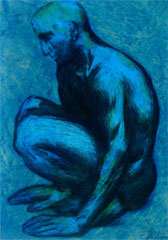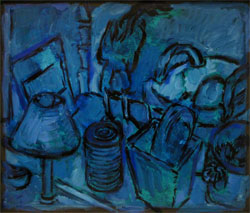|



|
"Blue Period"
Exactly one hundred years after Picasso, a painter comes along and entitles his exhibition with a wink "Periode bleue", instead of calling it simply "Blue Paintings" or "Paintings In Blue". Obviously, it is important to Andreas Jaeggi to call this newest working phase a "period", the expression meaning a limitation in time. It's quite possible that in 40 years' time some one will write similar phrases about Andreas Jaeggi as Gertrude Stein did in 1938 when she commented on Picasso: "During this period between 1901 and 1904, he painted the blue pictures. Harshness and reality made him create these paintings on which everything he produced later was based."
The idea of painting mainly in blue came almost by itself to Andreas Jaeggi: one of his city impressions – a street scene from Dublin, Ireland – done not unlike another painting which can be seen in this exhibition ("The Atlantis Bar in Basel"), became totally blue through the artist's search for simplification. This particular painting fascinated Andreas Jaeggi so much that he decided to develop this color as a project, exploring its various shadings and themes.
It is a particular thing, the color blue. During the times of the Egyptian pharaohes, it was the color of the gods. In the "evening land", the European west, it only started to be used from the 12th century on when it was finally possible to produce ultramarine blue from the semi-precious stone lapislazuli. The resistance from the church against this color only eased up when in religious painting the rule was firmly established that Mother Mary's coat should always be represented in blue, the most expensive ultramarine there was. Only after 1600 did blue become one of the primary colors. Later on, it's general use slowly increased and consequently became more and more popular. The flag of today's European Community shows blue as the ground color and most adults nowadays name blue as their favorite color.
In his book "About The Spiritual In Art", Wassily Kandinsky pointed out in 1920 the special effect of colored light on the entire body. He noted "that color bears an enormous strength in itself. Hardly any research has been done concerning this matter. This force is able to influence the entire human body as a physical organism. Generally speaking, color is therefore a means to influence the soul directly. Color is the key(board). The eye is the (piano)hammer. The soul is the piano with many strings. The artist is the hand which makes the human soul vibrate by purposefully activating one key or another."
Let's get back to Andreas Jaeggi. The exclusive use of blue in his newest paintings leads towards a particular effect because, normally, each color changes its value through the neighbourhood of one or more other colors. A blue splash in the middle of a red surface has a different appearance and value than the same blue in yellow surroundings.
For Jaeggi, blue gains incredible depth and yet, it moves towards the onlooker after longer observation. The objects and the bodies become three dimensional. They seem full of mystery. They shine from inside. What Jaeggi presents to us are neither night pictures nor romantic scenes because they offer too much resistance. It takes a certain time and effort until one can really "see" the original work and experience its effect or – as Kandinsky would have said: "until the soul begins to vibrate".
Views of street scenes and houses – such as the "Atlantis"-painting – radiate a great calmness due to the one color reduction. They are painted with density and solid composition, even if the chosen angle is often dynamic. The brush strokes are loosly applied and full of life. The contours have a mysterious swing. The effect of these paintings can be explained by this opposition of quietness and dynamics.
Andreas Jaeggi's nudes reflect the artist's interest in representing the unclothed body. He shows us the surface but searches to catch the charisma and to carefully depict their eroticism. In some paintings, the bodies of two lovers seem to be transparent, the couples penetrating each other and the two forms therefore become one harmonious entity.
Remarkable and new are the still lifes by Andreas Jaeggi. The subject of the still life, the representation of lifeless, unmoving and dead objects, started to appear in western European painting in the 16th century. At first, still lifes were probably part of a bigger scenic image and then slowly became an independent genre. What the artists aimed at in the beginning was copying nature with a deceiving realism and the pure joy of fully representing any given object. Later on, other aspects took over: the artists took possession of motifs, colors and shapes. They personalized the relationship between object and background. The simplest object can become the reason for an artistic analysis.
As far as Jaeggi's still lifes are concerned, the same observations may be applied as to his city impressions: there isn't one line which doesn't swing. There isn't one contour which is regularly drawn. Everything vibrates. What also enhances the dynamics is the seemingly casually chosen angle and section of the depicted view. The objects are unspectacular. They are taken from every day life and they are not arranged. But one can feel the artist's connection with these items: they mediate a certain feeling of safety / security. On the other hand, they can also be taken and actively used.
In order to judge Andreas Jaeggi's present artistic freedom and strength of expression, one has to be familiar with the artist's earlier work. These were almost photorealistic renditions. They were pictures executed with great precision and stupendous artistry. In the expressive and nervous way of painting his city impressions, Andreas Jaeggi has moved away from his earlier work, even if the knowledge of precise drawing still is and always was the base of his artistic freedom. His latest work has become even more free. The reduction to one single color as well as a further dissolving of the drawing leads towards harmonious pictures that seem to be caught almost mysteriously in a strange balance between calmness and dynamics.
By Steffan Biffiger for NY Arts Magazine / Berliner Kunst
|